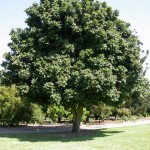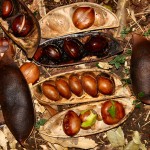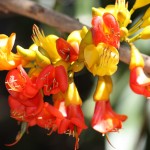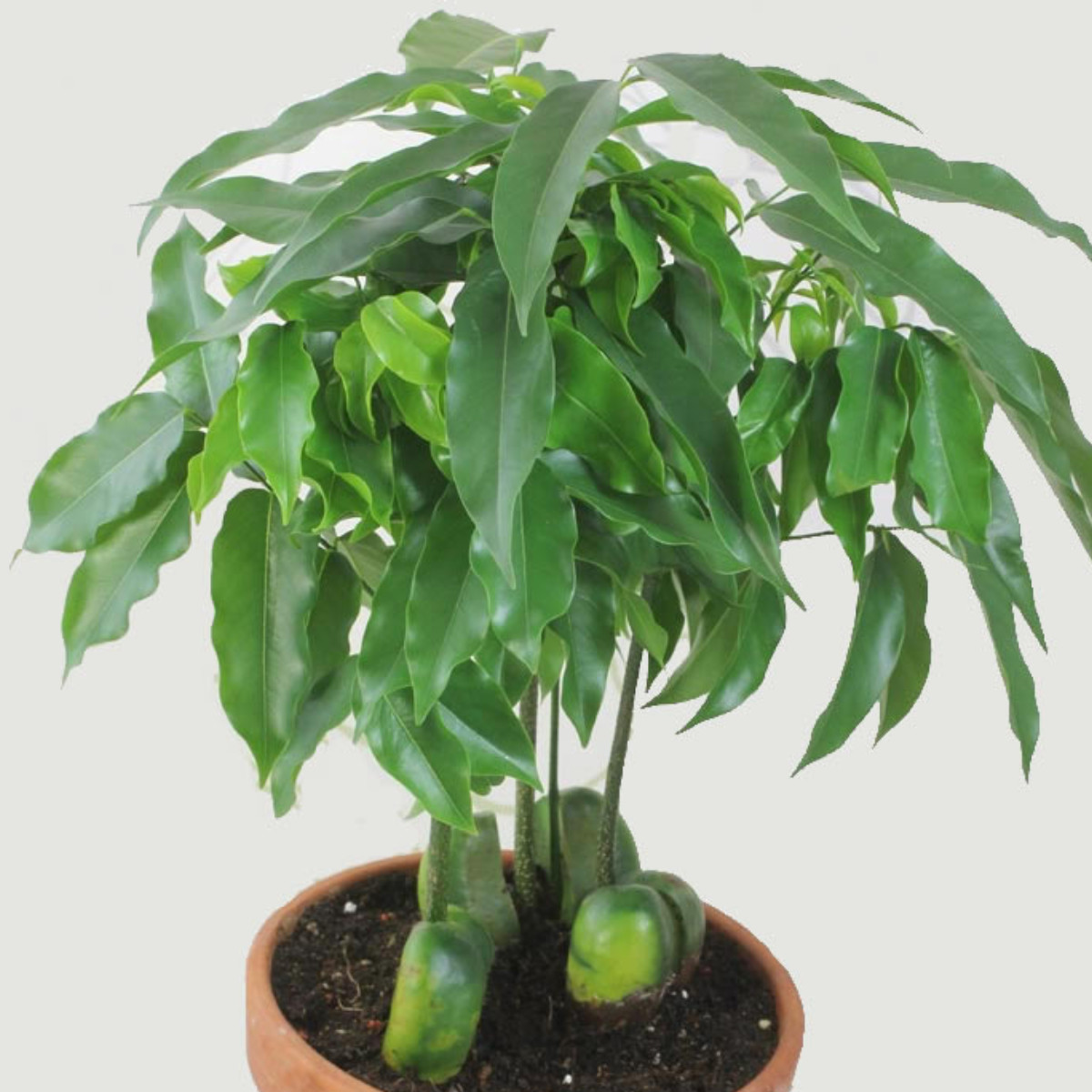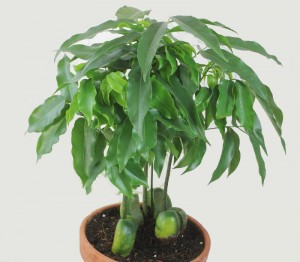Family: Fabaceae
Synonymous: Castanospermum brevivexillum
Castanospermum australe var. brevivexillum
Distribution and habitat: Castanospermum australe is native to coastal rainforests and beaches in the east of Australia and to the Pacific islands of Vanuatu and New Caledonia. It grows in moist, fertile, well-drained soils on terraces on the side of mountains or along the banks of rivers and streams. It is a large evergreen tree growing up to 40m (130 feet) tall, though commonly much smaller.
The tree is grown for its attractive glossy pinnate leaves sometimes reaching 60cm (24 inch) long and the leaflets range in size from 917cm (3.5-7 inch) in length, for its flowers and as a shade tree.
It will flower in late spring, early summer, summer or late summer. The flowers from this plant are hermaphrodite (has both male and female organs) and they are pollinated by birds and insects. The orange or yellowish pea-shaped flowers 4cm (1.5 inch) long are borne in clusters on the branches so that they are partially hidden by the leaves. The pods 20cm (8 inch) long and woody are produced and hang from the branch, containing 1-5 brown seeds 3cm (1 inch) in diameter.
It also makes an ideal indoor plant, especially as baby plant or when is young, as described below.
Description: Castanospermum australe makes an ideal indoor plant and is widely available in florists and nurseries as baby plant with the 'bean' attached to its base. Multiple plantings of plants will give a good display combining the dark shiny leaves of the tree with the novelty ornamental value of the giant seeds. It is an attractive evergreen plant. The "bean" in the common name Lucky Bean Plant refers to the large seeds partially exposed above the soil and from which the plants have sprouted. The 'bean' pod will naturally dry up and separate from the plant in several months and can be removed without any effect to the plant.
The bark is brown to grayish-brown and smells of cucumber if chopped. The leaf is pinnate, having 11-15 lustrous green leaflets that are oblong and slightly curving on the petiole, or leaf stem. The Castanospermum australe grows erect, developing a short stem with a small crown, usually roundish.
Keeping theCastanospermum australe dry and cool in the winter can encourage it to produce sprays of red and yellow pea-shaped flowers. These butterfly like blooms are quite hard to achieve in the living room, however, the whole plant is rather decorative even without them.
Cultivated as a houseplant, trees in this genus can grow into small, shrubby plants. Size can be controlled by keeping the plant in a relatively small pot and shaping these plants with pruning, trimming, and training. Prune as desired to keep the lush 'indoor forest' look. They can be kept trimmed at any height.
Houseplant care: Frequent pruning can control growth and form theCastanospermum australe into a bonsai-like short ornamental tree. This tree can be grown indoors or outdoors in a container.
The pottedCastanospermum australe can be placed outdoors during the warm months of spring and summer and taken inside again before the first fall frost.
Light: It will tolerate low, filtered light to full sun if gradually introduced.
It is important to select a location for theCastanospermum australe that will offer it sufficient space in all directions to grow and thrive. Provide it with lots of bright indirect light with a few hours of early or late day direct sun.
Temperature: It prefers temps in the 16-27C (60-80F) range. Provide a medium humidity and minimum temperatures between 10-24C (50-75F) for best results.
It will enjoy being stood outside in a rain shower which will also remove any dust that has collected on the leaves spraying regularly will help prevent dust build up.
Castanospermum australe could even be put outdoors on the patio or decking just be sure to bring it back indoors if the temperature falls below 10C (50F).
Water: Ensure that the potting mixture of theCastanospermum australe is always moist but do not allow roots to sit in standing water. Water it regularly. Soak the soil well at each watering and allow it to become dry to the touch before watering again.
In early fall and throughout the winter months, water just enough to keep the soil from drying out completely. Allow the top 3cm (1 inch) of soil to dry to the touch and then water it thoroughly.
Fertiliser: In the first year Castanospermum australe does not have to be fertilized. Afterwards liquid plant food may be added monthly from spring to summer. Instead granular fertilizer or spikes can be given in the beginning and the middle of the growing season.
Potting and repotting: Castanospermum australe should be kept in a small pot (no larger than a 10cm (4 inch) pot) until the soil dries out in 3 days or less. Move it to a 15cm (6 inch) pot, no larger than that. Each time it starts drying out too fast move it to a pot 5cm (2 inches) larger.
Castanospermum australeprefers nutrient rich soil that drains well. Soil can be general all-purpose potting soil or can be a mixture of soil, sand, lime and peat.
Fill a growing container to within 3cm (1 inch) of its rim with potting soil. Place the lucky bean plant into the soil at the same level it was previously growing. Replace the soil and tamp down. Add water until the soil feels very moist but not soggy.
Gardening: Within its hardiness zone rangeCastanospermum australe can make an excellent standalone garden feature or it may be used with a cluster of trees to create a privacy screen or shaded area in the garden.
Many people grow these indoors until they get large, then they can be planted out and used as a shade tree. Castanospermum australe is a hardy species that is suited for a wide range of conditions in frost free zones.
Position: Generally, these trees prefer full sun, however shady situations are tolerated. Also, it is tolerant of light frost for short periods. It grows best in full sunlight, which is defined as a minimum of six hours of sunlight per day and preferably eight hours.
Due to its extensive root system, it should not be planted within 10m (33 feet) of drainage lines, sewers, house foundations, garages or swimming pools. Also consider the wide canopy of the mature tree. In time this tree will provide a large amount of shade, making it a good choice for planting near patios or in areas where shade is welcomed.
Soil:Castanospermum australe requires a very well-drained but moist high-grade soil. Lightly amend heavy clay or sandy soils with organic matter.
It prefers best in loam type of soils.
Irrigation: Watering from a hose or sprinkler should be done slowly and deeply, but not frequently, to avoid shallow root development or root diseases. Allow soil to dry top 10cm (4 inch) before irrigating again.
Water new planted trees briefly two or three times a week to keep soil moist, not wet.
Be prepared to water during prolonged sunny, windy, dry spells even in the winter.
Woody plants need watering less frequently than young soft plants. Established trees can go weeks without supplemental watering except in extremely hot or windy weather.Castanospermum australe becomes drought tolerant once established and matured.
Mulches help prevent water loss during hot, windy, or sunny weather.
Fertilising: During the spring use a fertiliser rich in nitrogen and potassium to favour the development of the new vegetation. Irrigate well the tree after fertilising.
Propagation: Propagation of Castanospermum australe is from fresh seed. Germination requires a temperature of 18-25C (64-77F). Sow in large, individual tubes using a mix of 3 parts river sand and 1 part perlite. Transplanting should be done after the first pair of true leaves have formed. Plant the seedling in a bed of thoroughly loosened, moist soil, mulch around the base of the plant and water regularly. The Castanospermum australe is slow to establish but will respond to liquid fertiliser, which should be firstly applied 3 months after germination.
Problems: When grown as houseplant, Castanospermum australe is susceptible to some insects or fungal infestation.
May occasionally be affected by scale insects and psyllids.
Treatment: Use an adequate pesticide to control insects attacks.
Over-watering may cause fungal root rot. Yellowing leaves indicate over-watering.
Treatment: Withhold watering till surface of soil has dried. If planted indoor, move it out to a bright shade location and gradually place it out in the open to receive a good amount of sunlight for the plant to bounce back.
Toxicity: The leaves and seeds are toxic, Keep the plant away from pets and small children.
Note: The seeds are poisonous, but become edible when carefully prepared by pounding into flour, leaching with water, and roasting.
Uses: Castanospermum australe as indoor plants, where their fast early growth and attractive glossy leaves make them a decorative feature for homes and offices.
It is an ideal shade tree in parks, resorts and gardens, in addition it has a strong root system, which can be used to consolidate stream banks against erosion
SUMMARY:
CHARACTERISTICS:
Foliage green
Shape upright
PROPER CARE:
Watering in rest period sparingly
Watering in active growth period plentifully
Light bright filtered
Temperature in rest period min 10C max 15C (50-59F)
Temperature in active growth period min 16C max 27C (60-80F)
Humidity medium
Hardiness zone: 9b-11
